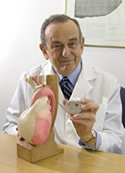History
 The great things being achieved by URMC Cardiology are firmly rooted in the past. The University of Rochester Medical Center was one of the nation’s first academic medical centers. It was created in the early 1900s following the release of the Flexner Report, a watershed event in the history of medical care in our country.
The great things being achieved by URMC Cardiology are firmly rooted in the past. The University of Rochester Medical Center was one of the nation’s first academic medical centers. It was created in the early 1900s following the release of the Flexner Report, a watershed event in the history of medical care in our country.
In his report of 1910, Abraham Flexner noted that medical schools in the U.S. were sorely lacking in quality. Flexner proposed that medical schools be attached to universities and require strict standards of their medical students. The Flexner Report revolutionized medical education across America.
URMC was one of the first institutions formed in accordance with Abraham Flexner’s recommendations. In 1920, Flexner along with Dr. Benjamin Rhees and Mr. George Eastman proposed to build a new university, medical school, and hospital in Rochester. This medical center would adopt Flexner’s novel ideas.
As the incidence of heart disease increased in America, medical treatment of cardiovascular diseases grew in importance. In 1957, the Cardiology Unit at URMC found an exceptional leader in Paul N. Yu, M.D. Under Dr. Yu’ s leadership from 1957-1982, the Cardiology Unit helped advance the field of cardiology through its work in electrocardiography and exercise stress testing. During this time, the cardiac catheterization laboratory also made many important research contributions.
URMC was a key to furthering our understanding of one of the most cataclysmic medical events: the heart attack. As one of ten units in the country selected by the National Institutes of Health to study the early effects of myocardial infarction—heart attack—URMC helped to identify clinical factors that are important in early diagnosis. This research impacted hospitals throughout the nation, helping to improve care for tens of thousands.
Research at URMC continues to change cardiology, both in the U.S. and around the world. Work by URMC researchers Arthur Moss, M.D. and Wojciech Zareba, M.D., Ph.D. in the areas of sudden death, heart failure and Long QT Syndrome has helped developed revolutionary new treatments that have saved thousands of lives.
Under the leadership of Charles Lowenstein, M.D. who joined URMC Cardiology in 2009, the Department of Cardiology is continuing its legacy of improving cardiology care—both for people in our community, and for those around the globe.
Read a more detailed history